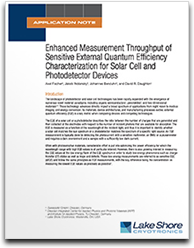M81-SSM resources
APP NOTE
The Lock-in Amplifier Explained and Reimagined

During material or device characterization, lock-in amplifiers enable very low amplitude measurements of the frequency of interest in the presence of large broadband noise and large spurious signals at other frequencies.
This app note examines how the lock-in technology employed in a modular source measure architecture deals with removing the effects of noise from the measurement. It details how the M81-SSM offers:
- Filters designed to remove noise and decrease measurement time
- Multiple measure options, with the flexibility of measurement configurations
- Multiple source modules, which can be matched to measurement requirements
APP NOTE
FIR vs. IIR Filtering for Faster Lock-in Measurements
 When characterizing a device, you often look for a small response to some sort of stimulus, such as AC current. But frequently, this is done in the presence of a DC offset as well as a lot of noise — which often
can be larger than the signal itself. The typical way to obtain the sought-after level of response is to use a lock-in amplifier.
When characterizing a device, you often look for a small response to some sort of stimulus, such as AC current. But frequently, this is done in the presence of a DC offset as well as a lot of noise — which often
can be larger than the signal itself. The typical way to obtain the sought-after level of response is to use a lock-in amplifier.
The output stage filter is a key component of lock-in detection. Traditionally, a low-pass recursive filter (RC filter), also known as an infinite impulse response (IIR) filter, has been used as the output filter on lock-in amplifiers. The issue is, for suitable rejection of higher-frequency components, IIR filters require long wait times for settled values.
In this app brief, we examine using a different type of filter: the moving average filter or finite impulse response (FIR) filter. We discuss the performance of the two filtering methods and demonstrate measurement advantages of this filter over the traditional IIR filter while describing the output filter feature of our MeasureReady™ M81-SSM synchronous source measure system.
DownloadAPP NOTE
Minimizing the Effect of Common-mode Noise Interference in Low-temperature Applications

This app note explains how the M81-SSM synchronous source measure system provides many unique source and measure capabilities that enhance noise rejection in low‑level signal applications, such as differential (balanced) source and measure connections. In addition, it details how the CMR function of the system's BCS-10 module can be used to increase the accuracy and decrease the noise of measurements.
DownloadTECH NOTE
A New Approach to Low-Level Measurements of Nanostructures

Electronic device structures are getting increasingly smaller. And because they're smaller, they can only tolerate extremely low stimulus currents and voltages, which reduce measurable signals close to the noise floor of typical instrumentation and experimental setups. This technical note explores a new approach to making such low-level signal measurements, one that utilizes optimum sensitivity, noise rejection, and uninterrupted acquisition of data as a means to characterize such materials more confidently.
DownloadAPP NOTE
Sensitive EQE Characterization for Solar Cell and Photodetector Devices

In this application note, we demonstrate a new approach to sensitive external quantum efficiency (sEQE) characterization as a means to measure the lowest EQE values possible for organic solar cell and photodetector technology research. We discuss:
- Conventional instrumentation used for an sEQE measurement
- The alternate approach that employs a synchronous source measure system
- I-V sweeps and lock-in detection of a device's induced AC photocurrent
- The results of an sEQE measurement performed on a C60:ZnPc organic solar cell device using the M81-SSM platform

WEBINAR
A New Concept in Semiconductor Material/Device Characterization Combining DC and AC Sourcing and Measuring

Traditionally, material/device characterization applications have required a combination of specialized DC and AC instruments — often resulting in complicated setups. Such setups often employ long cables between instruments and the sample, and as channel counts increase, so do the challenges of minimizing system noise and ensuring channel-to-channel timing and reference frequency synchronization. This webinar, held in conjunction with AZoNetwork, details a new approach: the use of a highly synchronized, AC + DC sourcing and measurement system that utilizes remote analog modules for optimum sensitivity and noise rejection to characterize samples accurately.
Watch now
